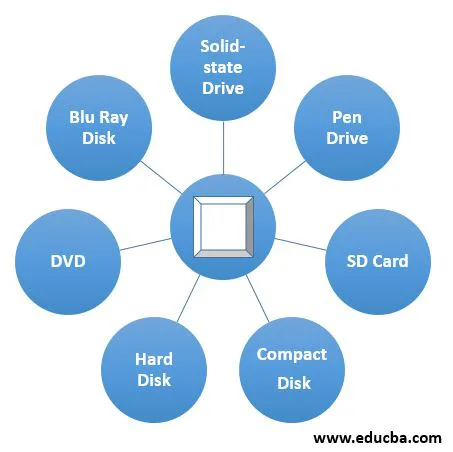
Introduction to Secondary Memory
You know that memory for the processor is both costly and limited, and is also known as main memory. The quicker primary memory is volatile as well. We need a lower cost and permanent memory if we need to store large amounts of data or programs permanently. The secondary memory is called this. We ‘re discussing secondary storage devices for storing large amounts of data, audio, video, and multimedia files here. Secondary memory also applies to various storage media on which data and programs can be stored by a device. Specified or removable secondary storage media. Fixed storage media is a hard disk-like internal storage media that is attached to the computer. The portable storage medium which can be taken outside the computer is called removable storage media.
Top Secondary Memory Devices
Let’s have look at Secondary Memory.

1. Solid-state Drive
Also, SSD is a non-volatile storage medium for storing and accessing data. It offers many advantages over SSD as opposed to a hard disk, such as faster access time, lower power consumption, noiseless operation, and more. With the downward cost of SSD, it has become an excellent replacement on laptop and desktop computers for a standard hard drive. Also suitable for tablets and notebooks with little storage.
2. Pen Drive
A secondary portable storage system is Pen Drive. The USB flash drive, thumb drive, or a jump drive is also known. It connects via a USB port to a computer. It is often used for storing and transferring information across computers. For instance, a report can be written using a computer, then copied or transmitted to the pen drive. Later, to access or edit your paper, you can connect the pen drive to a device. In the pen drive, you can also store important documents and images, music, and videos and keep them in a secure place. The pen drive has no moving parts; it includes a built-in circuit memory chip to store data. The chip is housed within an aluminum or plastic housing. The storage capacity of the pen drive is usually 2 Gigabytes to 128 GB. It is also a play device and plug because there are no further drives, hardware, or software needed for use.
3. SD Card
Secure Digital Card stands for SD Card. It is often used on mobile devices like smartphones and digital cameras. You can remove it from your system, and you can see the stuff stored there on a card reader computer. The SD card contains several memory chips that save the data. There are no moving parts. SD cards are not identical, so they can differ in speed, size, and capacities from one another. Normal SD cards, micro SD cards, and mini SD cards are some examples of SD cards.
4. Compact Disk
Compact Disk is around a medium disk portable secondary storage device. It consists of plastic polycarbonate. In 1982 Philips and Sony co-developed the concept of CD. The first CD was made at the Philips workshop in Germany on 17 August 1982. It was used in the beginning to store and play sound recordings and later was used to store documents, videos, audio files, and other data such as software on a CD.
5. Hard Disk
It is a rigid magnetic disk used for data storage. It stores data permanently and is located inside a drive. The hard disk is also called a hard drive. It is a rigid magnetic disk that permanently stores data, as it is a non-volatile storage unit. The hard disk is situated in a drive unit on the motherboard of your computer and consists of one or more disks packed in an airtight case. The data is written on the plates when a magnet head is passed over the plates while spinning.
6. DVD
Philips, Panasonic, and Toshiba co-developed their DVD in 1995. For Digital Various Disk or Digital Video Disk, the DVD is short. It is an optical media form used to store optical data. While it is the same size as a CD, it has a much larger storage capacity than a CD. It is also commonly used to store and display films and to distribute software programs as they are too big to fit on a CD.
7. Blu Ray Disk
Blu Ray Disk (BD) is a high-definition (HD) and multi-mediate file optical storage media. Compared with DVD /CD, BD uses shorter laser wavelengths. This allows the writing arm to concentrate more closely on the disk and thus to pack more data. Up to 128 GB of BD can be stored.
Recommended Article
This is a guide to Secondary Memory. Here we discuss the Introduction of Secondary Memory and its different devices like Solid-state Drive, pen Drive, SD Card, etc. in detail. You can also go through our other suggested articles to learn more –
